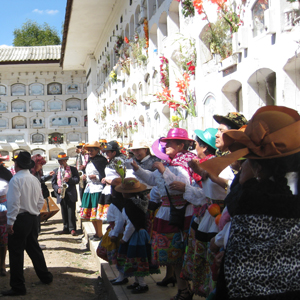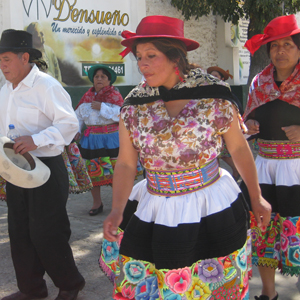Santiago Dedicated to Grandma Rosa
Grandma Rosa loved celebrating Santiago, a Peruvian Andean tradition in honor of the Saint Santiago. When she passed away, she left behind six children and joined six other children who had passed away before her. In her honor and memory, the family and extended family reunite once a year to celebrate Santiago in her name with some family members coming in from as far away as Argentina and Italy.

A full band accompanies the reunited family members as they dance from the chapel to Grandma Rosa’s grave, the men flanked on either side by two rows of ladies. They are headed by the great-aunts, the sisters of Grandma Rosa who exude a certain zest even in their eighties. It’s a sight to see them parading through the streets with the women fully clothed in colorful, traditional Santiago wear and the men raising their sombreros.
After filling her resting place with fresh flowers, each person greets Grandma Rosa by touching the glass that covers her tombstone and making the sign of the cross. Some say a little prayer, and then it’s off to the other side of the cemetery where her brother-in-law lays. Although the family only visits these two pavilions, the cemetery is actually filled with aunts, uncles, sons and daughters who have passed away.

How do you commemorate loved ones past?
Tags: andean traditions, santiago andes, santiago huancayo, santiago music, santiago peru



bornstoryteller
In Jewish ways, we light a candle at a certain time of the year in the deceased's memory. It is called a Yahrzeit. Click http://judaism.about.com/od/judaismbasics/a/How-T… for further info.
Samantha Bangayan
Ooh! I've never heard of this before. Candles are so symbolic. =) Love this idea, Stu!
Abe
This post has touched my heart deeply as my Maria is in flight to Huancayo at this moment. Her dad (the man who raised her) passed away three days ago. She was traveling to Lima anyway to care for him before he passed but time was not on his side. Maria was saddend by his death but not as saddend as she was to find out that the traditional acts were not followed. She had told me of all the traditional cerimonies, chewing the Coca, dressing in black for a year, the gathering of the community and all the people with a band. Non of this took place. A step sister who has lived in Lima for all her adult life took charge of everything and choose NOT to follow the traditional ways. She returned his body to Ahuac (near Chupaca) Burried him only and told no one even my wife Maria. All Maria could keep repeating was " what about the tradition of the people. How could she have done that"
Samantha Bangayan
I'm so sorry to hear that not only was Maria not able to make it on time, but that they also no longer continued tradition. The traditions have changed here too as we no longer dance with animals in the city. At the same time, when it comes to commemoration, I always feel that things should be celebrated as the person past would have liked for it to be. I so hope that Maria is able to spend quality time with her family and that hopefully, the time may make up for the changes. Thanks so much for sharing this, Abe.
Adrienne
Wow, that is a great way to celebrate her life. How long has she been gone Samantha?
We don't celebrate like that for the passing of loved ones. My family does visit our family cemetery a couple times a year to pay our respects and we enjoy a really great lunch before leaving town. We've always tried to celebrate their lives instead of dwell over their passing.
Wonderful tribute Samantha, thanks for sharing.
My recent post Do You Make These Mistakes In Facebook?
Samantha Bangayan
I think she's been gone for around 8 to 9 years now. Thanks for asking, Adrienne!
You know, with my own family in Canada and my ancestors in the Philippines, we don't even have a tradition like you do. I love the idea of celebrating lives rather than dwelling on the passing. =) That's something I'll be remembering and implementing. =)
GigLogo
That is so BEAUTIFUL Sam! That is the type of celebration and family unity I like to see. When it is the anniversary of death of a family member I usually get a call from my mother who tells me to light a candle or say a prayer for the deceased person, but that was before Facebook so maybe that will change since the family is better connected. Many blessing to you and your family : )
My recent post Guest Blogging – The Greatest Form of Free Advertising for Your Small Business Web Site
Samantha Bangayan
Exactly, Karla! I became sure that Peru could be a second home for me when I saw how important family was here too. Ooh, I like the idea of lighting a candle or saying a prayer — and how funny to think that we can now use social media to commemorate loved ones past. =) It's definitely a great way to stay connected to everyone! =)
@oneshoeshy
It is, indeed, a wonderful celebration and remembrance. Thank you for sharing this tradition.
My recent post {this memory} 12
Samantha Bangayan
Aww thanks for saying so, Thom! =) I really enjoyed writing about this too! =)
Vinny T
Thank you for that wonderful post. I memorialize my dearly departed loved ones in a less elaborate manner, though in a way very meaningful to me. I have pictures of my departed and most beloved relatives in my bedroom. Each day, upon awakening, i look at each of those pictures and remember what made each f them special, and during the day try to do at least one good deed or special act of kindness in their memory. And before going to sleep at might, i again look at each of their pictures to thank them for their contributions to my life and to acknowledge their memory that lives forever in my mind.
Samantha Bangayan
That's what most important, Vinny — the meaning behind it all! In my opinion, remembering through pictures is one of the best ways to because you can visualize your loved ones. =) And what a beautiful way to remember their lives — by passing on kindness and showing thankfulness. =) Thanks so much for sharing that — it's a habit I'd like to implement in my life as well. =)
penniej2
Hi Samantha,
I had never heard of a celebration quite like this one. It must be more typical of that area of South America. Wonder where its roots came from. Every culture seems to have some interesting cultural farewell. I like ones like the Irish wakes or the America memorial services or even – don't know what it is or where it's from – having a party in the deceased's name. That sounds more like what they have for Grandma Rosa, but with costumes, the traditional walk/parade, beer stops, and the annual celebration. In Mexico, it's a trip to the undertakers', elegant but nonetheless, to give your pesame and then attend one of nine Masses for the Dead – probably one of the few times most people go to Mass except for weddings..For some reason, lacks Peruvian or Latino warmth.
My recent post Encounter with A Narco
Samantha Bangayan
It's a very Andean tradition as they don't do Santiago anywhere else in Peru, unless there's a community from the Andes there!
Wow! I love thinking about how different cultures remember the deceased. Mass is really important here too, but it seems to only be a part of the party. =) I'll always remember learning about the Mexican Day of the Dead, which should be similar to the same holiday here. That's a type of celebration, isn't it? =)
penniej2
The Day of the Dead is a type of celebration, quasi religious and with some features of the pre-Colombian celebration. (BTW, mixing the two is very common in Mexico and probably across Latin America.) While there are processions and sugar skulls (to eat) and people don grotesque costumes, it's mainly more serious – about visiting the panteon and leaving flowers on graves, creating a little altar in honor of your dead loved ones (my sister always has one), orange flowers – cempoasuchitl – pan de muertos, and attending Mass to remember the departed. Humorists write verses called calaveras making fun of the living, friends, personalities, co-workers, and then of course, there's always a party to celebrate the dead.
My recent post My Seven Deadly Links
Samantha Bangayan
Wow! The Day of the Dead in Mexico sounds very similar to the Peruvian-style holiday as well! I've only been here for one Day of the Dead and I didn't find any sugar skulls — I'll have to look out for them next time. Roy says that he hasn't heard of calaveras used to refer to verses before. We both thought you were referring to skeletons! =)
penniej2
Will send you a "calavera" on the Day of the Dead.
My recent post My Seven Deadly Links
Samantha Bangayan
Can't wait!! =) Love the idea of "celebrating together" in this way, Pennie! =)
My recent post My Seven Links in Peru
Hilda
I remember a love one who past away by light incents and putting food near their picture and think about all the awsome times we had. Then years later, I come back to the love one's grave and do the same thing. Basically an anniversary saying i will never forget them 🙂
My recent post Asians Breaking into the Industry
Samantha Bangayan
Ooh! I can so imagine that, Hilda. Incense can be a powerful memory. The incense and food near the picture is very similar to what they do here for the Day of the Dead in early November. =) Thanks so much for sharing what you do, Hilda!
Sherry Zander
I truly enjoy it when you share about the celebrations in Peru. Americans have lots of general celebrations and even celebrate and commemorate the lives of famous Presidents, but where I live we seldom commemorate locals with annual events like this. I think it's touching and inspirational!
My recent post Writing and Trauma — an Exercise in Healing
Samantha Bangayan
It’s true, Sherry! I wonder if smaller towns in America have their own traditions with a similar style. Thanks so much for your comment! =)